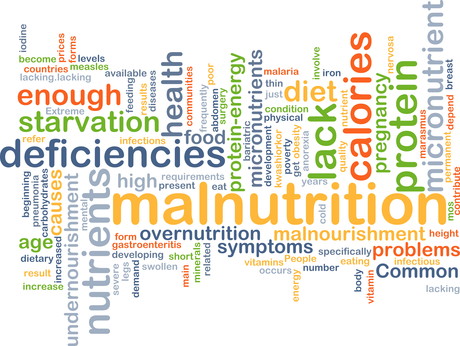Why do we need to address malnutrition?

Malnutrition is an under-recognised and underdiagnosed healthcare issue in Australia. It can result from poor oral intake, increased nutritional needs as a consequence of disease and or poor absorption, or excess nutrient losses associated with disease.
Many contributing factors can increase the risk of developing malnutrition, including: age, mental state, presence of disease, poor food access, reduced mobility or difficulty swallowing, as well as side effects of treatment.
Malnutrition results in negative health outcomes. It impairs the body’s immune response, making it more susceptible to infection and more difficult to treat infection. Malnutrition also increases the risk of developing pressure injuries and delays wound healing. It contributes to weight loss, weakness, greater susceptibility to falls and reduced endurance as a consequence of reduced muscle strength and size.
Thus, patients in hospital diagnosed with malnutrition will be at a higher risk of infectious and non-infectious complications, and tend to have longer lengths of stay than well-nourished patients1.
Incidence of malnutrition and cost to the healthcare system
Surprisingly, malnutrition is not limited to developing countries during times of famine. It is a relatively common problem in the hospital environment in developed countries such as the US, Europe and Australia, with incidence rates between 20 and 50%1.
The Australian Nutrition Care Survey completed in 2010 identified 30% of hospitalised patients as malnourished, with 6% of patients being severely malnourished.
Australian studies have estimated the additional annual cost to individual hospitals to be between $1.6 and 1.8 million1.
Prevention and treatment of malnutrition
Western Health in Melbourne has implemented an inpatient malnutrition strategy that incorporates a combination of nutrition screening, assessment and treatment for those identified as malnourished or at high risk of malnutrition.
Nutrition support initiatives introduced to facilitate increased oral intake of patients include communal dining, volunteer meal assistance to help with meal-time socialisation and set-up, and the use of Red-Domes placed over patients’ meals to identify patients requiring full feeding assistance from nursing staff.
As a component of this rollout, in 2010 Western Health introduced the ‘Dining with Friends’ program, a supportive communal dining environment in the aged-care, subacute setting, where patients were invited to consume their lunch in the dining room three days per week. The dietitians at Western Health then audited the impact this program had on the patient’s intake of energy and protein and found that patients were happier to eat in the dining room when compared to their bedside2.
Also, those who attended the group consumed on average 20% more energy and protein in the dining room compared to the bedside. When the group was subdivided into high risk categories for malnutrition, the impact of the dining program remained evident with:
- Patients screening as at risk of malnutrition (MST > 2) consuming 42% more energy and 27% more protein in the dining room.
- Patients underweight for their age (BMI < 22 — as mean age was 79 y (BMI 22–27)) consuming 30% more energy and protein in the dining room.
- Patients with a cognitive impairment (MMSE ≤ 25) consuming 30% more energy and protein in the dining room.
- Patients reporting a poor appetite consuming 25% more energy and 31% more protein in the dining room.
- The program has now been successfully extended to a 5-day-per-week service.
It is important to note further research is still required to analyse the impact of the nutrition programs on outcomes — including complication rates such as hospital acquired malnutrition, progression of identified malnutrition/malnutrition risk, infection rates, incidence of pressure injuries and length of stay.
References:
1. Barker L, Gout B, Crowe T. Hospital malnutrition: prevalence, identification and impaction on patients and the healthcare system. International Journal of Environmental Research and Public Health 2011; 8: 514–27 http://www.mdpi.com/1660-4601/8/2/514
2. Markovski K, Nenov A, Ottaway A, Skinner E. Does eating environment have an impact on the protein and energy intake in the hospitalized elderly? Nutrition & Dietetics 2017, 74: 224–228 http://onlinelibrary.wiley.com/doi/10.1111/1747-0080.12314/full

Remote laundries target preventable disease in NT communities
A new community laundry has launched in Borroloola, part of a program seeking to curb preventable...
Eye care partnership looks to support First Nations optometrists
A new scholarship initiative will support Aboriginal and/or Torres Strait Islander optometrists...
A Day in the Life of a mobile optometrist
Linda Nguyen is the owner and founder of mobile optometrist practice Care Optometry and was a...

![[New Zealand] Transform from Security Awareness to a Security Culture: A Vital Shift for SMB Healthcare — Webinar](https://d1v1e13ebw3o15.cloudfront.net/data/89856/wfmedia_thumb/..jpg)
![[Australia] Transform from Security Awareness to a Security Culture: A Vital Shift for SMB Healthcare — Webinar](https://d1v1e13ebw3o15.cloudfront.net/data/89855/wfmedia_thumb/..jpg)




